标签:
一、代码理解
1.env文件夹-environ.c代码
#include <stdio.h>
#include <stdlib.h>
int main(void)
{
printf("PATH=%s\n", getenv("PATH"));//getenv函数用来取得参数PATH环境变量的值,执行成功则返回该内容的指针
setenv("PATH", "hello", 1);//见下方解释
printf("PATH=%s\n", getenv("PATH"));
#if 0
printf("PATH=%s\n", getenv("PATH"));
setenv("PATH", "hellohello", 0);
printf("PATH=%s\n", getenv("PATH"));
printf("MY_VER=%s\n", getenv("MY_VER"));//版本
setenv("MY_VER", "1.1", 0);
printf("MY_VER=%s\n", getenv("MY_VER"));
#endif
return 0;
}
【setenv函数的作用?】
setenv用来在本次函数运行的过程中增加或者修改环境变量。当最后一个参数不为0的时候,原来的内容会被修改为第二个参数所指的内容。
2.env文件夹-environvar.c代码
#include <stdio.h>
int main(void)
{
extern char **environ;
int i;
for(i = 0; environ[i] != NULL; i++)
printf("%s\n", environ[i]);
return 0;
}
【environ变量是什么?】 该变量指向一个叫“environment”的字符串数组。包括USER(登录用户的名字),LOGNAME(与user类似),HOME(用户登录目录),LANG(地域名),PATH等
3.pipe文件夹-consumer.c代码
#include <stdio.h>
#include <stdlib.h>
#include <string.h>
#include <fcntl.h>
#include <limits.h>
#include <sys/types.h>
#include <sys/stat.h>
#define FIFO_NAME "/tmp/myfifo"
#define BUFFER_SIZE PIPE_BUF
int main()
{
int pipe_fd;
int res;
int open_mode = O_RDONLY;
char buffer[BUFFER_SIZE + 1];
int bytes = 0;
memset(buffer, 0, sizeof(buffer));
printf("Process %d opeining FIFO O_RDONLY \n", getpid());
pipe_fd = open(FIFO_NAME, open_mode);
printf("Process %d result %d\n", getpid(), pipe_fd);
if (pipe_fd != -1) {//open函数正常执行
do {
res = read(pipe_fd, buffer, BUFFER_SIZE);
bytes += res;
} while (res > 0);不断地从fifo文件中读取数据,知道==直到数据被读完
close(pipe_fd);
} else {
exit(EXIT_FAILURE);
}
printf("Process %d finished, %d bytes read\n", getpid(), bytes);
exit(EXIT_SUCCESS);
}
【PIPE_BUF的值是多少?】 4096字节
【memset函数用法?】 原型:memset(void *s,int ch,size_t n);将s中前n个字节用ch替换并返回s
【open函数用法?】
open(const char *pathname,int flags);第一个参数是欲打开的文件路径字符串,第二个参数是打开方式
【FIFONAME是什么?】
这里需要补充一下fifo的含义,它是一种文件类型,可以通过查看文件stat结构中的stmode成员的值来判断文件是否是FIFO文件。fifo是用来在进程中使用文件来传输数据的,也具有管道特性,可以在数据读出的时候清除数据。
4.pipe文件夹-pipe.c代码
#include <stdio.h>
#include<stdlib.h>
#include <unistd.h>
#define oops(m,x) //当linux系统执行代码遇到问题时,就会报告oops
{ perror(m); exit(x); }
int main(int ac, char **av)
{
int thepipe[2], newfd,pid;
if ( ac != 3 ){//输入的命令长度不等于3
fprintf(stderr, "usage: pipe cmd1 cmd2\n");
exit(1);
}
if ( pipe( thepipe ) == -1 ) //以下是各种错误
oops("Cannot get a pipe", 1);
if ( (pid = fork()) == -1 )
oops("Cannot fork", 2);
if ( pid > 0 ){
close(thepipe[1]);
if ( dup2(thepipe[0], 0) == -1 )
oops("could not redirect stdin",3);
close(thepipe[0]);
execlp( av[2], av[2], NULL);
oops(av[2], 4);
}
close(thepipe[0]);
if ( dup2(thepipe[1], 1) == -1 )
oops("could not redirect stdout", 4);
close(thepipe[1]);
execlp( av[1], av[1], NULL);
oops(av[1], 5);
}
5.forkdemo3.c文件
#include <stdio.h>
#include<stdlib.h>
#include<unistd.h>
int main()
{
int fork_rv;
printf("Before: my pid is %d\n", getpid());
fork_rv = fork(); /* 创建子进程 */
if ( fork_rv == -1 ) /* 出错的情况下即子进程创建失败 */
perror("fork");
else if ( fork_rv == 0 ){ //子进程的返回值才是0
printf("I am the child. my pid=%d\n", getpid());
exit(0);
}
else{//父进程执行这段代码
printf("I am the parent. my child is %d\n", fork_rv);
exit(0);
}
return 0;
}
6.testbuf3.c文件
#include <stdio.h>
int main()
{
fprintf(stdout, "1234", 5);
fprintf(stderr, "abcd", 4);
}
【关于fprintf函数】
函数原型:int fprintf(FILE *stram,const char *format,[argument]);第一个参数是文件指针,第二是输出格式,第三个是附加参数列表。也就是说,该函数会根据指定的格式(format)向输出流(stream)中写入数据(argument)。
二、代码执行时的问题
1.argv,env文件夹中的代码可以正常运行。
2.execl1执行
在直接 gcc execl1 -o execl1.2(因为之前已经有execl可执行文件了)之后,系统提示如图。

后来改变方法,先生成.o 文件再生成可执行文件,就可以执行代码了。
通过网上搜索,发现出现这个错误提示是因为使用了第三方库而没有把它的.m文件添加到compile source中去,而是可能只把这些文件copy到当前文件夹里就觉得可以了;这样在直接编译链接执行的时候根本没有自动引用(网上提供的解决方法建立在专门的编写软件基础上,在target--build phases--compile source中添加.m;不过针对我们的情况,可以分步完成以保证最终生成可执行文件)。
3.consumer执行
开始的时候直接gcc consumer.o -o consumer仍然出现上文中的错误。后来删除consumer .o 文件之后分步编译,可以执行。
4.producer.c函数运行
开始的时候,提示有错误。如图。
后来查询了access函数,发现它的功能是确定文件或者文件夹的访问权限。如果指定的存取方式有效,则返回0;否则返回-1.其中,f_ok只是判断该文件是否存在。而整个函数需要头文件<unistd.h>。加上该头文件之后,代码可以正常编译。
三、代码执行情况
1.一些不停地打印的代码,sigdemo2为例的那些根本停不下来的代码
注:无法停止时,control+c强行停止
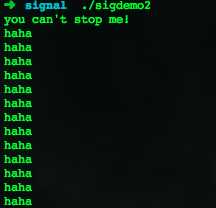
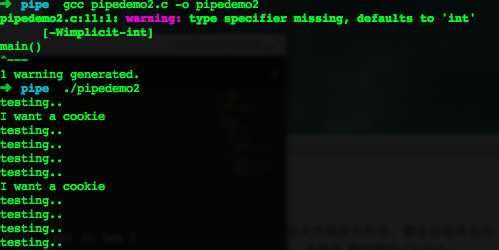
2.一些需要等待时间才能出来的代码(含有sleep)
(1)每隔两秒的sigactdemo2.c

(2)每隔30s的watch.sh
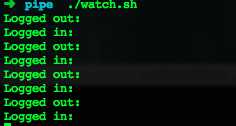
3.输入什么就打印什么或执行什么
(1)输入什么就打印什么
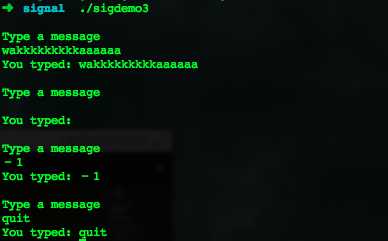
(2)输入什么就执行什么
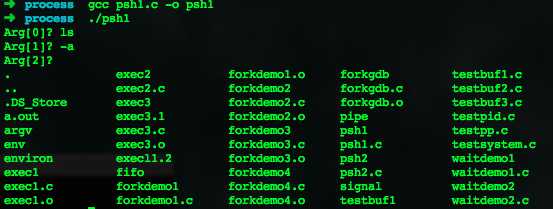
3.没有结果(无输出,只是申请一个20字节的内存大小)

4.发现代码的最后一句打印不出来,自行修改后得到结果

由这个变为最后加上打印OUCH

标签:
原文地址:http://www.cnblogs.com/L20135304/p/5005593.html